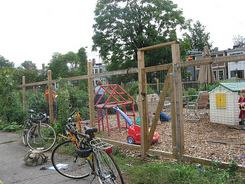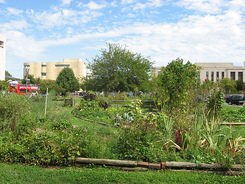Growing possibilities: A new census of community gardens
A squadron of bicyclists armed with satellite mapping instruments swept through the District this summer on a unique mission: locate all of the city’s community gardens and interview garden managers for the first ever census of community gardens here.
There are nearly 40 community gardens in DC, but until now, there has been no readily available estimate of the square footage of public land being cultivated for food in the District of Columbia, nor is there a coordinated land management strategy citywide. These are among the issues this census, undertaken by the Neighborhood Farm Initiative, was intended to address.
As I bicycled around town with the Farm Initiative’s staff and volunteers, I discovered that the city’s community gardenscape is well hidden. Community gardens are secreted between alleyways, under a highway overpass, behind a tall fence covered in vines. Others hide in plain sight: there were fruit trees and raised beds in a triangle of land across from the Air and Space Museum. Just blocks from Nationals Stadium, a neat plot of land in full sun teemed with life.
The Kingman Park-Rosedale Community Garden had the tallest basil plants I had ever seen. As he pulled radishes from the ground, a young gardener at Independence Community Garden near the Air and Space Museum told us that he lives alone and he grows more than he can eat. At King’s Court Community Garden on Capitol Hill, garden manager Pat Taylor gave us basil and squash along with her insight into community organizing strategy.
These gardeners had food to share: possibilities for partnership between community gardens and food access programs such as Ample Harvest or the Grow a Row at the Capital Area Food Bank abound.
The census underscores stark realities about food access in the District. Wards 1 through 6 have a greater concentration of community gardens as well as a greater concentration of supermarkets and food retail centers.
But there are signs of change. Ward 8, for instance, recently added a new community garden, Shipley Community Garden at 23rd and Savannah streets SE. Health advocates east of the Anacostia River are looking at food gardening as a way to address childhood obesity.
Another new urban garden, Justice Park, is slated to be built on a vacant lot at 14th and Euclid streets NW in Columbia Heights. The city’s recreation department recently announced $25,000 in funding from Whole Foods to help install garden planters at 56 recreation centers throughout the District.
As more community gardeners sprout up, NFI’s educational programs can teach them how to grow food sustainably. At their half-acre space near Fort Totten, they also host weekend workshops and volunteer workdays.
Data for the community garden census is currently being compiled and analyzed. If you know of a community garden in operation as of September 2009 whose manager was not contacted by NFI for inclusion in this garden census effort, please contact NeighborhoodFarm@gmail.com.
Cross-posted at DC Food For All.



